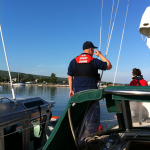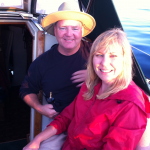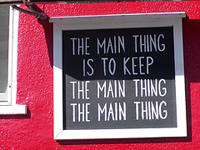I just returned from ten days sailing Lake Superior. After crossing from Bayfield to Grand Marais, our plan was to take three or four days circumnavigating Isle Royale, one of my favorite destinations. Five miles outside of Grand Marais’ harbor LOON’s water pump broke, and with absolutely no wind we were dead in the water. The bad news was breaking down, waiting three days in Grand Marais for a part from Massachusetts and having to change our plans. The good news was that it didn’t happen in a storm, in the middle of Lake Superior or on a rocky lee shore of Isle Royale. Also, since we were basically bobbing like a cork just outside Grand Marais’ harbor, likely presenting a navigational hazard, North Superior’s Coast Guard kindly towed us into port. (Not to mention that if you’re stranded anyplace, Grand Marais is a pretty good deal!)
Whenever sailing LOON, especially on longer cruises, I almost always learn something new about seamanship, and usually lessons that translate to leadership and life. Lesson #1 on this cruise was “count your blessings, and make the most of the hand you’re dealt.” Not only were we spared the danger of breaking down in a far worse place; we learned about water pumps, got to explore Grand Marais as never before, rested up and discovered a master marine mechanic (Randy at A&E Marine in Grand Marais.) As we’ve heard, “wherever you go (or don’t go,) there you are!” I was reminded that there are simply some things that we cannot control or plan for; we just have to deal with them and adapt.
I was also reminded of a lesson that I learned early, and that is reinforced on every sail: “Get the right people in the boat, and the wrong ones off it.” Mike, Angelika, her daughter Lisa and friend  Zoya were no doubt unhappy about our breakdown and change in plans, but you’d never know. They didn’t overreact, helped where they could and took full advantage of all that Grand Marais had to offer. They never complained about being stranded in the harbor as our power drained, kept the captain and crew fed, and helped make it an enjoyable experience nevertheless.
Zoya were no doubt unhappy about our breakdown and change in plans, but you’d never know. They didn’t overreact, helped where they could and took full advantage of all that Grand Marais had to offer. They never complained about being stranded in the harbor as our power drained, kept the captain and crew fed, and helped make it an enjoyable experience nevertheless.
After repairs, we had just enough time for an overnight sail to Isle Royale and a day of exploring Windigo’s trails. All sails out, cruising at a comfortable clip under a starry sky and passing the Rock of Ages light at dawn, we couldn’t have asked for anything more. As it turned out, we arrived on perhaps the season’s best day; a ranger told us that the prior two days were cold and rainy. Our 18-hour return crossing was uneventful except for an amazing sunset, shooting stars and a spectacular sunrise over Lake Superior.
Our 18-hour return crossing was uneventful except for an amazing sunset, shooting stars and a spectacular sunrise over Lake Superior.
My biggest takeaway from this cruise was realizing that a journey can be successful even if we do not reach our intended destination. The lessons and experiences may be different ones than we planned, but if we are open to them may yield more in the end. The day after we returned, 61 year-old Diana Nyad began her quest to swim the 103 miles from Cuba to Miami. Injured and sick from exhaustion, she ended her attempt about half way. She did not reach her intended destination, but I would not call her attempt a failure. To even set that goal, condition herself for achieving it and accomplish what she did at 61 is inspirational. Think about 3M’s “failed” attempts at making glue stick that led to Post-It Notes, or when Christopher Columbus failed to find a northwest passage to China in 1492 and what he found instead.
Does it look like you might not reach your intended destination? What unexpected opportunities might you take advantage of? How can you capitalize on the situation?
What lessons can you take away from any “failures” or unsuccessful efforts to reach a destination?
It is good to have an end to journey for, but it is the journey that matters in the end.
Ursula K. Le Guin
The pessimist complains about the wind, the optimist expects it to change, and the realist adjusts the sails.
William Arthur Ward
Contact me, and I will be happy to send you my collection of “SeaChange” lessons for life and leadership gathered from over 2,000 miles of sailing adventures.
Fair winds!









 We will need the courage of entrepreneurs and other pioneers who to put their ideas, innovations and resources on the line, without any certainty of success and distinct possibilities of rejection. Our recent economic climate has been especially challenging for those with untested ideas and business propositions; the temptation is strong to invest energy and resources in only the sure bets. To succeed, entrepreneurs’ courage will need to be matched by the “en-courage-ment” of markets and investors.
We will need the courage of entrepreneurs and other pioneers who to put their ideas, innovations and resources on the line, without any certainty of success and distinct possibilities of rejection. Our recent economic climate has been especially challenging for those with untested ideas and business propositions; the temptation is strong to invest energy and resources in only the sure bets. To succeed, entrepreneurs’ courage will need to be matched by the “en-courage-ment” of markets and investors. Authentic leaders possess not just the courage of their convictions, but the courage to have their convictions challenged. “Truth” is a team sport; our communities and institutions will be better off when we collaboratively seek truth instead of attempting to convince each other that we already possess it. When already convinced that we alone know the truth we end up with the entrenched positions, gridlock, vitriol and even violence that politics has descended into instead of true dialog in the public’s best interest.
Authentic leaders possess not just the courage of their convictions, but the courage to have their convictions challenged. “Truth” is a team sport; our communities and institutions will be better off when we collaboratively seek truth instead of attempting to convince each other that we already possess it. When already convinced that we alone know the truth we end up with the entrenched positions, gridlock, vitriol and even violence that politics has descended into instead of true dialog in the public’s best interest. Sometimes we lose courage and fail to act because we’ve told ourselves stories about, or exaggerated potential consequences. We fear rejection, for example, believing that the rejection will be personal versus the rejection of just an idea. Sometimes organization members don’t speak up because they fear job consequences when there has been no history of that, or perhaps an isolated incident many years in the past under different leadership.
Sometimes we lose courage and fail to act because we’ve told ourselves stories about, or exaggerated potential consequences. We fear rejection, for example, believing that the rejection will be personal versus the rejection of just an idea. Sometimes organization members don’t speak up because they fear job consequences when there has been no history of that, or perhaps an isolated incident many years in the past under different leadership.